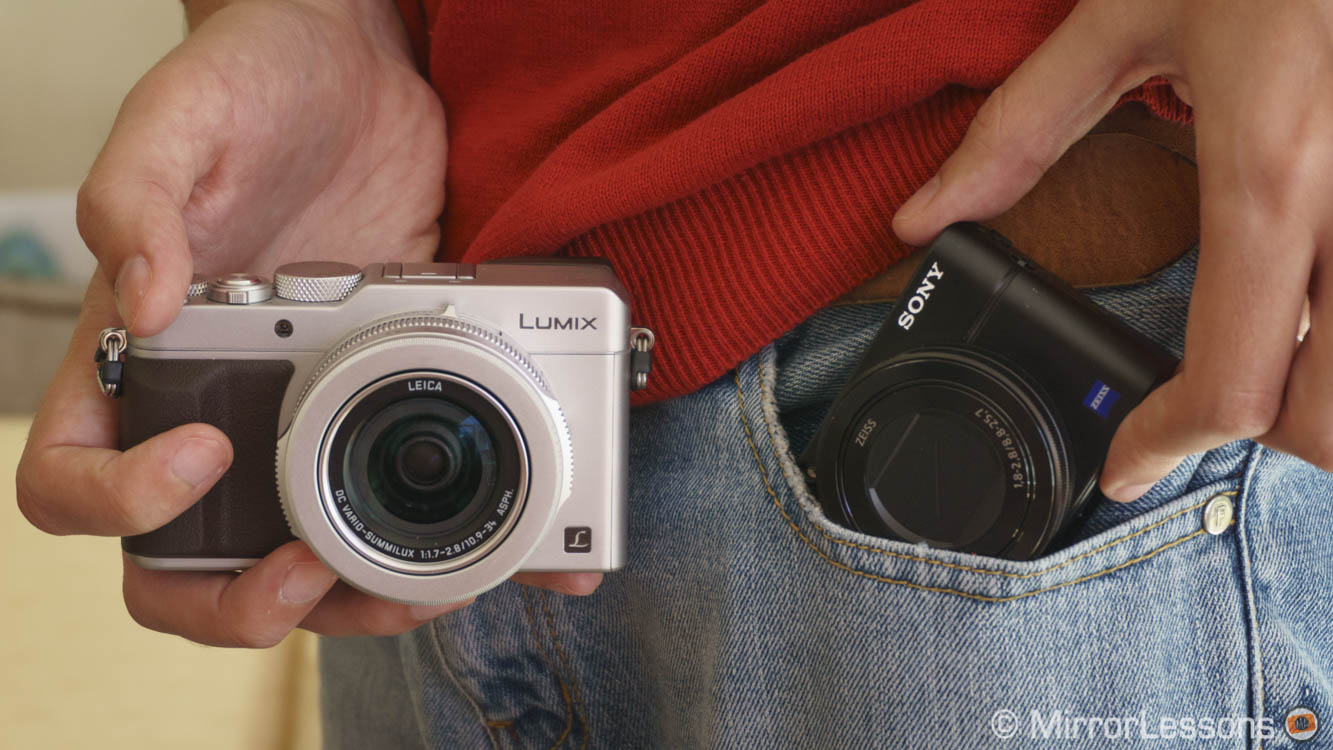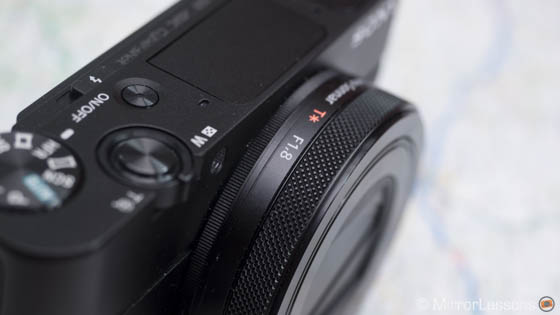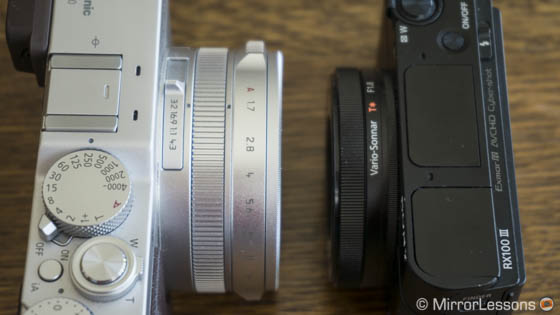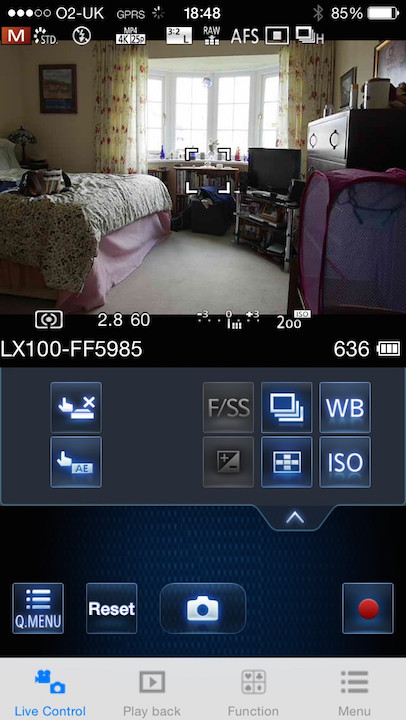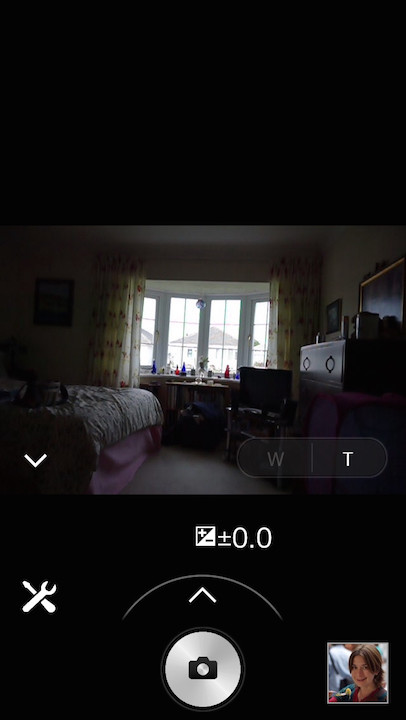Update: this article now includes my complete findings for both the RX100 mark III and mark IV.
When we published our comparison between the LX100 and the Fujifilm X100T, many of you asked us to do the same for the Lumix camera and the Sony RX100 series. The two cameras belong to the same “premium compact” category and are both very appealing options, so the question was a logical one. I first wrote this article comparing the Lumix camera with the RX100 mark III. Now that our RX100M4 review is online, I went on to update the article with my findings about the latest premium compact camera from Sony. Now you might ask yourself why we’ve chosen to do a three-way camera comparison instead of just the two most recent models from each brand…
Well, the main reason is that the RX100 mark III, in my opinion, is still a more than suitable option.
Most importantly, now that the mark IV has been released, the mark III has come down in price and that is not something to underestimate.
The mark IV is a very expensive premium compact camera with a retail price of nearly $1000. It is a lot for a camera that, in the end, might act only as a back-up to another camera or system. So the mark III makes perfect sense, not only because of its price but also because its features are still up-to-date.
The most relevant improvements made to the RX100 mark IV concern continuous shooting and video capabilities. Unless shooting sports, 4K or slow motion video is a priority, the RX100 mark III will do the job just fine.
[stextbox id=”text-box”]
Editor’s note: Given the many similarities between the two Sony cameras, this comparison is built mainly around the LX100 vs. RX100M3. I highlighted in blue the sentences and paragraphs related to the RX100 mark IV. To make this article as easy to read as possible, you will often find two columns. On the left I talk about the LX100, while on the right I talk about the RX100 M3/M4. You will also find some sentences in green that highlight a significant advantage of one of these cameras. Red sentences highlight a weak point.
[/stextbox]
So, are you ready for a side-by-side comparison between these three technological marvels? Let’s begin!
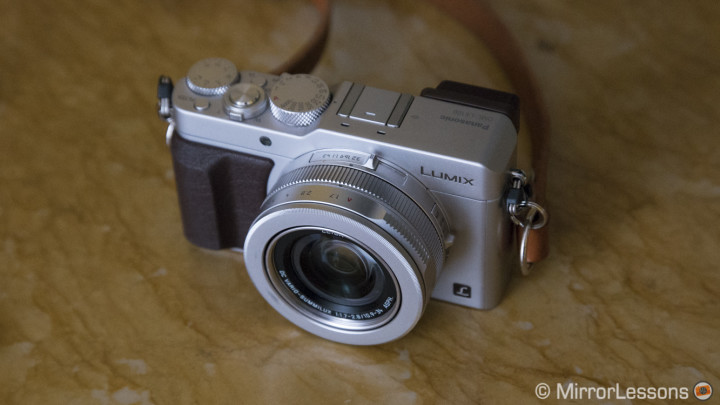
Panasonic LX100
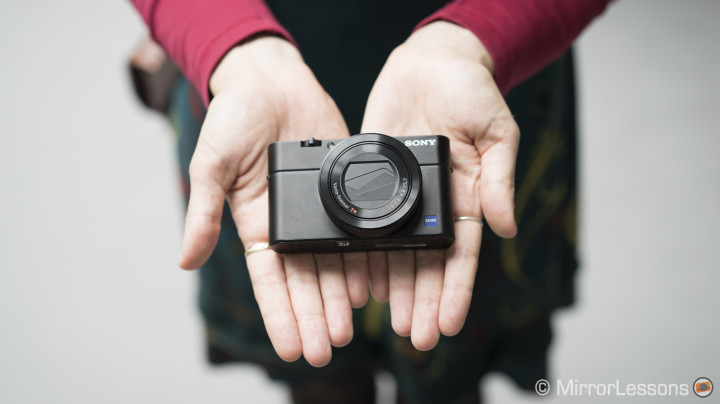
Sony RX100 mark III/IV
[toc heading_levels=”3″]
Main specs
There are many differences between these two cameras, from the sensor size to the design and button/dial layout.
The LX100 incorporates a 16MP Micro Four Thirds sensor but due to the nature of the camera, the entire sensor surface isn’t used (effective resolution is 12MP). This is due to the multi aspect ratio technology that I will explain later on. The camera can record video up to 4K. It features manual exposure controls with an aperture ring and a shutter speed dial that will satisfy even the most demanding photographers.
The Sony RX100 features a smaller 1 inch sensor but has more resolution (20mp). Its button layout is similar to your average compact camera which makes it a little bit less attractive for advanced users.
The mark III can record video in Full HD up to 60fps.
The mark IV can record 4K video, as well as stunning slow motion footage up to 1000fps.
These two cameras serve a similar purpose: to give you the best image quality in the most compact package.
They also share some similarities, the most important being the lens and the viewfinder. They both feature a fast aperture zoom lens (f/1.7-2.8 and f/1.8-2.8 respectively) with almost the same coverage of 24-70mm (the LX100 actually has 5mm extra on the telephoto end). They both have a built-in EVF.
[expand title=”The Panasonic LX100 Main Specs”]
- Sensor: 16.8 million pixels MFT sensor (12.8mp effective pixels)
- Lens system: fixed 10.9-34mm (24-75mm in 35mm equiv.) f/1.7-2.8
- Weatherproof: No
- Internal Stabilisation: Yes (Power O.I.S.)
- Autofocus: Contrast AF with 49 points and DfD technology
- Continuous shooting: 11 fps (S-AF), 7 fps (C-AF)
- ISO Sensitivity: 200 – 25600 ISO (extended down to 100)
- Shutter Speeds: 1/4000 to 60 seconds, 1/16000s with electronic shutter
- Viewfinder: electronic viewfinder with 2,764k dots, approx. 100% FOV coverage and 1.39x magnification
- LCD Screen: fixed 3″ LCD monitor (921k dots)
- Movie recording: 4K up 25fps, FHD up to 60fps
- Built-in Flash: No (but external flash provided)
- Extra Features: WiFi, NFC, 4K Photo, Stop Motion, Interval Time Shooting, Multiple exposure, Silent Mode
- Dimensions: 114.8 x 66.2 x 50mm
- Weight: 393g (including battery and memory card)
[/expand]
[expand title=”The Sony RX100 Mark III Main Specs”]
- Sensor: 20 million pixels 1 inch sensor
- Lens system: fixed 8.8-25.7mm (24-70mm in 35mm equiv.) f/1.8-2.8
- Weatherproof: No
- Internal Stabilisation: Yes (Optical Steadyshot)
- Autofocus: Contrast AF with 25 points
- Continuous shooting: 10 fps (S-AF), 2.9 fps (C-AF)
- ISO Sensitivity: 125 – 12800 ISO (extended down to 80, 100, up to 25600 with Multi-NR)
- Shutter Speeds: 1/2000 to 30 seconds
- Viewfinder: electronic viewfinder with 1,440k dots, approx. 100% FOV coverage and 0.59x magnification
- LCD Screen: Tilting 3″ LCD monitor (1,228k dots)
- Movie recording: Full HD up to 60fps, HD up to 120fps
- Built-in Flash: Yes (but external flash provided)
- Extra Features: WiFi, NFC, Panorama
- Dimensions: 101.6 x 58.1 x 41mm
- Weight: 263g (including battery and memory card)
[/expand]
[expand title=”The Sony RX100 Mark IV Main Specs”]
- Sensor: 20 million pixels 1 inch sensor
- Lens system: fixed 8.8-25.7mm (24-70mm in 35mm equiv.) f/1.8-2.8
- Weatherproof: No
- Internal Stabilisation: Yes (Optical Steadyshot)
- Autofocus: Contrast AF with 25 points
- Continuous shooting: 16 fps (S-AF), 5.5 fps (C-AF)
- ISO Sensitivity: 125 – 12800 ISO (extended down to 80, 100, up to 25600 with Multi-NR)
- Shutter Speeds: 1/2000 to 30 seconds, 1/32000s with electronic shutter
- Viewfinder: electronic viewfinder with 2,345k dots, approx. 100% FOV coverage and 0.59x magnification
- LCD Screen: Tilting 3″ LCD monitor (1,228k dots)
- Movie recording: 4K up to 30fps, Full HD up to 120fps, Slow motion up to 1000fps
- Built-in Flash: Yes (but external flash provided)
- Extra Features: WiFi, NFC, Panorama
- Dimensions: 101.6 x 58.1 x 41mm
- Weight: 263g (including battery and memory card)
[/expand]
Design and ergonomics
More than specs, image quality or performance, I think that the main decisives factors are: size, grip and controls.
Both cameras have a good build quality with a metal and plastic finish. They feel solid but dropping them even just once could be lethal. They lack any form of weather sealing.
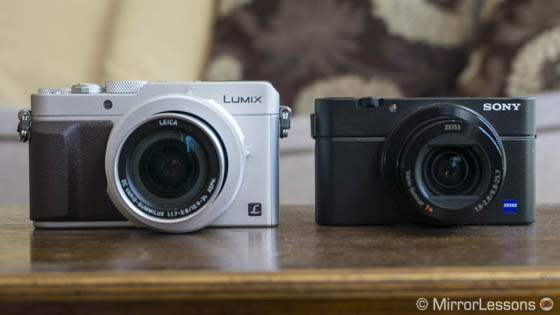
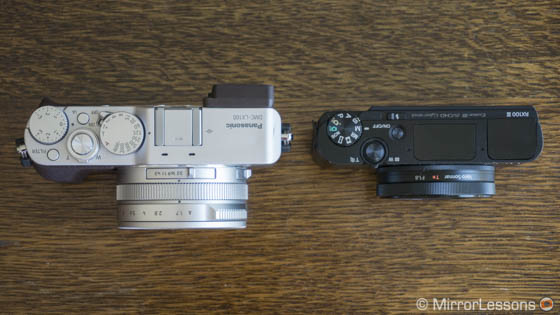
The LX100 is larger and looks like a small rangefinder camera with some modern touches. It is available in black or silver but the latter’s markings (shutter speed dial and aperture ring) are a little too hard to read sometimes. The paint on the surface also tends to come off more easily. The battery and USB/HDMI port are well-designed and feel solid to open/close.
The faux-leather front and rear grip, along with the larger body, make the LX100 easier to hold and manipulate. The lens is also larger and more prominent, so it is easier to hold and adjust the various controls such as the aperture or manual focus ring.
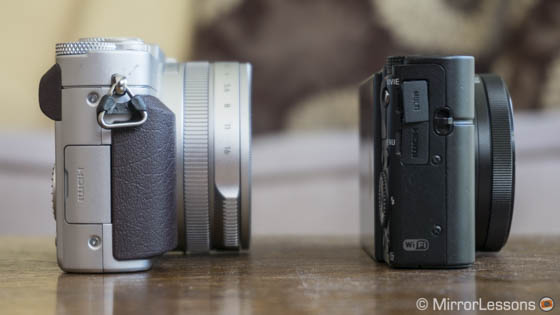
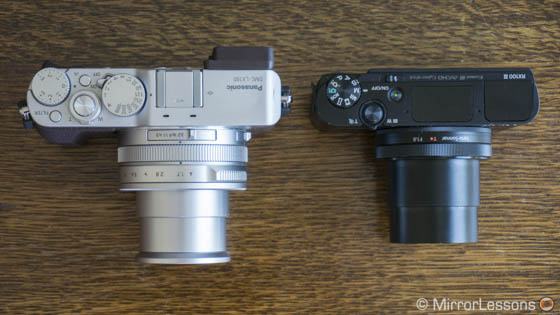
The RX100 is smaller and only available in black. It looks like your average compact camera and can fit inside your jean pocket. That is its main strength for sure. It has an elegant and minimalistic design. The USB/HDMI ports as wells as the tilting LCD screen feel fragile however.
While the smaller body is certainly a plus in terms of compactness, the grip is inevitably less effective especially for someone like me who has big hands. There is no grip whatsoever on the front and the thumb grip on the rear is too small. Often while using the camera I inadvertently pressed a random button on the rear. It is best to hold the camera with two hands as you would with most compact cameras or smartphones.
[stextbox id=”text-box2″]
About the RX100 m3/m4 grip
To enhance the grip of the RX100 mark III/IV, you can either purchase the official Sony AG-R2 front grip (it sticks on the front of the body) or a half-case such as the Gariz HG-RX100M3BR. Gariz has also designed a separate case (XS-RX100M3BR) for those who wish to use it with the AG-R2 grip. Please note that I haven’t personally tested these accessories on the RX100. I have experience with the Gariz cases on other cameras and I would probably choose that solution if it were my personal camera.
[/stextbox]
One little detail you appreciate about the RX100 mark III/IV is that the lens has an automatic cap incorporated into the lens that opens/closes when you turn on/off the camera. The LX100 has a classic removable lens cap that can easily pop off when the camera is inside a bag for example. Panasonic did include a cap cord but I personally don’t like having a lens cap hanging off the camera. There is however the option to purchase the DMW-LFAC1K lens cap that will open/close automatically.
[stextbox id=”text-box”]
Note about the RX100 mark 4 Design
The only update to the mark IV in comparison to the mark III is the texture on the function ring and the presence of an HFR mode on the main dial, so the design is pretty much identical.
[/stextbox]
Functionality and Ease of Use
Both the LX100 and RX100 III/IV offer a good user experience but the LX100 is definitely more intuitive. The external controls for adjusting exposure are certainly the most relevant difference but also the AF/MF switch on the side of the LX100 is quicker to deal with than a quick menu or a function button.
But this is also the nature of the two cameras: one is larger with more controls, the other is smaller and fits pretty much anywhere.
The mechanical aperture ring, shutter speed dial and exposure compensation dial make the LX100 very intuitive to operate. The aperture ring works in 1/3 Ev clicking steps with good detent resistance and only becomes a little weak between 1.7 and A (Auto). Photographers who like physical and manual controls on their cameras will be pleased. The dials are sturdy and easy to operate as well. Only the exposure compensation dial is a little flimsy. Having an additional ring for manual focusing is also useful. Being an electronic function ring, you can use it for 5 different settings in addition to its default functionality.
The only dial the camera has is the shooting mode dial on top. To control your exposure, you can use the function ring on the lens or the command wheel on the rear. These are certainly less pleasant commands. For example, to switch between shutter speed, aperture or exposure compensation, you have to press the bottom part of the command dial first, then rotate the same dial. The overall button layout is good as far as the build quality is concerned but there are a lot of buttons placed in a very limited space. The function ring on the lens can be used for 9 different functions.
On the mark III, the function ring on the lens is often slow to react. I didn’t use it very often.
On the mark IV, the function ring is more reactive and precise. I used it to zoom in and out by steps.
The LX100 has a pre-configured command wheel on the rear where you can quickly set your ISO sensitivity, drive mode, AF mode and white balance value. By rotating the wheel you can fine-tune the shutter speed pre-selected with the dedicated dial on top. There are also three Fn buttons that you can customise with 39 different options. The quick menu button will also allow you to access additional settings such as metering, movie recording settings and picture profiles. Most of the buttons are solid and easy to reach with your fingers. The handy AF/MF switch can also activate the macro mode. The aspect ratio switch on top is also easy to access.
To zoom in or out, you can either use the lever on top designed around the shutter release button or assign it to the function ring on the lens. I prefer the former option. You can also choose to have the zoom lens jump between the main focal lengths (24, 35, 50, 70 and 75mm) or travel smoothly throughout the entire range.
The command wheel is also pre-configured for certain functions such as drive mode, flash mode, display mode and exposure setting. Only the left (Drive) and right button (flash) can be configured with another setting. The centre button is also customisable in addition to the C button for a total number of four custom buttons. The Fn button serves as a quick menu with 12 settings available. You can customise them inside the menu of the camera. To switch between AF or MF you can use either a customisable button or the Fn/Quick menu. There isn’t a specific Macro AF mode.
To zoom in or out, you can use the default lever on top or the function ring. With the RX100 mk3, I tend to not use the function ring at all.
Since it is more precise and reactive on the RX100 mk4, I often find it useful to set the control ring to zoom in steps.
Both cameras come with an LCD screen and an electronic viewfinder.
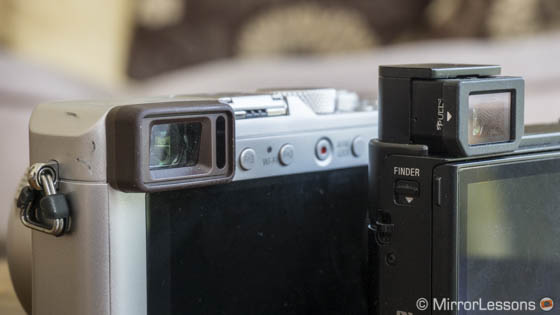
The LX100 EVF has more resolution (2764k) but with slight smearing on the finder glass. You can set the live view to either 30fps or 60fps for both the LCD and the EVF but performance decreases in low-light conditions. You can manually adjust brightness, contrast, green/magenta and warm/cool tints. The eye sensor is also faster when you bring the camera to your eye.
The RX100 mark III/IV feature a built-in pop-up EVF that is quite stunning considering the small size of the camera. It also features the Zeiss T* coating that makes it clear both at the centre and in the corners. You can set the display quality to High or Standard and adjust brightness and colour for both. The eye sensor is also fast. Personally I only used it when I really feel the need as I find it too small. Even in a backlit situation where it can prove useful, the fact that it is small means it doesn’t entirely shade your eye from the sun’s rays.
The mark III EVF has less resolution (1,440k dots).
The mark IV EVF has more resolution (2,345k dots) and also a better time lag.
The pop-up viewfinder can also be used to turn the camera on or off. On the mark III, this can become annoying however because you can’t deactivate this specific action.
On the mark IV, there is the option to disable the Powering Off feature when you close the EVF.
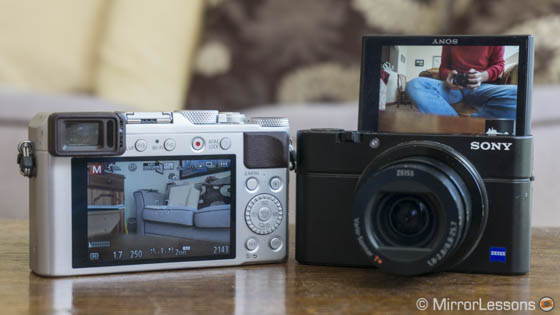
Both cameras have a good LCD screen but the RX100M3/M4 screen can be tilted up 180° (selfie mode) and down 45°. I wish that the LX100 had a tilting screen as well. Neither has touch sensitive capabilities but while Sony hasn’t integrated such technology on any of its mirrorless cameras as of yet (except for the a5100), I don’t understand why Panasonic didn’t add it to the LX100. The touch screen capabilities on other Lumix cameras are the best you can find on the mirrorless market.
Two final notes for this chapter regard the menu interface and the battery charging options.
The camera has the same menu system as the other Lumix cameras. It is my favourite menu system by far and I rarely get lost when I’m looking for a certain setting.
The camera comes with a dedicated battery charger but can’t be charged via USB.
The Sony menu system is more confusing for sure. Despite having used their cameras quite a lot, I am sometimes still not sure where to find a specific setting.
The cameras comes without an external charger but the USB port can be used. This is an interesting option because you can charge it with a mobile charger such as the [easyazon_link cloaking=”default” keywords=”Anker Mini” localization=”default” locale=”US” nofollow=”default” new_window=”default” tag=”easyazon-textlink-20″]Anker Mini[/easyazon_link].
Image quality: sensor



As stated at the beginning of this comparison, the RX100 has a 1-inch type sensor with 20MP. The chip includes BSI (Back-side illumination) technology that increases the sensitivity (BSI is also used on the Samsung NX1 and the recent A7r mark II).
The RX100 mark IV has the same sensor as the mark III model so the image quality is the same. I haven’t found any relevant differences in ISO performance, dynamic range and colour reproduction (click here to see an ISO comparison between the two Sony cameras).
The LX100 has a 16MP Micro Four Thirds sensor (the same found on the GX7). However the Panasonic lens doesn’t cover the whole sensor area but only an average of 85%. The reason for this is the multi-aspect ratio possibility offered by the camera.
[stextbox id=”text-box2″]
The LX100 multi-aspect ratio
Before we begin, let it be known that you can choose different aspect ratios on the RX100 or any other camera for that matter. In this case 3:2 is the native sensor aspect ratio but 1:1, 4:3 and 16.9 are also selectable. When you select the second, third or fourth option, the camera will simply crop on the horizontal or vertical line to produce a JPG with the ratio selected (the Raw file remains unaltered at 3:2). The result is a different diagonal angle of view when not using the original 3:2 aspect ratio.
With the LX100, things are a little different. The camera uses a lower megapixel count (between 12 and 9MP) depending on the selected aspect ratio. The lens doesn’t cover the whole surface of the sensor so while it is indeed a Four-Thirds sensor, the effective area used by the camera is always cropped for multi-aspect shooting and that results in having the same diagonal angle of view for any given ratio (except 1:1).
- Before (sliding to the right): RX100 aspect ratio
- After (sliding to the left): Multi-aspect ration on the LX100
[twentytwenty]

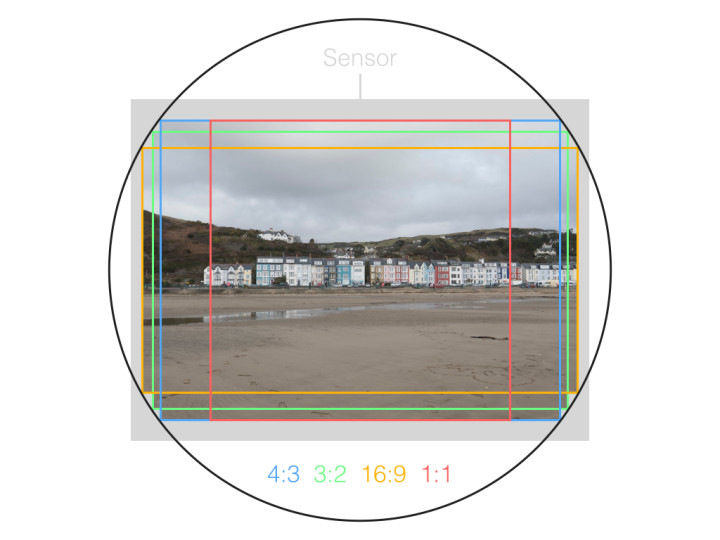
[/twentytwenty]
Now is this difference relevant? In my opinion, not really.
Personally I rarely use a different aspect ratio than the original sensor dimensions so the multi-aspect feature isn’t a big deal for me. Yes, the LX100 keeps the same diagonal field of view but it has less resolution, even if the difference between 16MP and 12MP is negligible. For this comparison, I always used 3:2 to match the RX100’s sensor aspect ratio.
[/stextbox]
Let’s see what the other relevant differences between the cameras are, starting with colour reproduction. This is an aspect that can also be a matter of personal taste. When it comes to the Raw files, the differences are almost non-existent. Both produce a balanced colour rendition. In some examples like the yellow flower below the Sony camera gives slightly more saturation to the image.
- Before (sliding to the right): LX100, 1/500, f/ 8, ISO 200
- After (sliding to the left): RX100M3, 1/320, f/ 8, ISO 125
[twentytwenty]


[/twentytwenty]
- Before (sliding to the right): LX100, 1/1000, f/ 2.8, ISO 200
- After (sliding to the left): RX100M3, 1/1000, f/ 2.8, ISO 125
[twentytwenty]


[/twentytwenty]
- Before (sliding to the right): LX100 1/1000, f/ 5.6, ISO 200
- After (sliding to the left): RX100M3, 1/250, f/ 5.6, ISO 125
[twentytwenty]


[/twentytwenty]
With the JPGs, which are more faithful to the picture profile chosen, the LX100 has the typical colour rendering of Lumix cameras. They are rich and modern (or digital if you prefer). There are 6 picture profiles and each offer basic levels of customisation including contrast, saturation, sharpness and noise reduction. I usually set the profile to standard or vidid. If you work with Auto White Balance, the Panasonic will tend towards a cooler rendering and in some cases it is quite evident.
The RX100 tends to have slightly more contrast and in some cases a more yellowish tint especially when the WB is set to Auto. Also, the metering tends to underexpose more in comparison to the LX100. There are 13 picture profiles to choose between. Here as well I tended to use standard or vivid.
With the RX100 mk4, you also use the Picture Profiles designed for video if you want a “cinematic” look for stills as well.
- Before (sliding to the right): LX100, 1/320, f/ 8, ISO 200 – OOC JPG – Vivid Profile
- After (sliding to the left): RX100M3, 1/200, f/ 8, ISO 125 – OOC JPG – Vivid Profile
[twentytwenty]


[/twentytwenty]
- Before (sliding to the right): LX100, 1/125, f/ 4, ISO 200 – OOC JPG – Standard Profile
- After (sliding to the left): RX100M3, 1/60, f/ 4, ISO 125 – OOC JPG – Standard Profile
[twentytwenty]


[/twentytwenty]
The dynamic range capabilities are surprisingly similar despite the sensor size difference.
Both deliver versatile Raw files especially in the shadows. In the highlights, the LX100 has a slight advantage especially in the brightest areas like the setting sun but the difference is not huge. I was able to post process the images in the same way and I didn’t find any relevant limits with one or the other. DR is of course more limited with the JPG but both cameras give you the option to expand it for JPGs as well. In drastic situations like the examples below, they won’t be too effective but in normal situations, they can reduce the contrast and give a more interesting look.
With the LX100 you can play with the shadows/highlight settings and a graphic curve for a maximum of 5 steps.

The sensitivity of both cameras is also very similar and the RX100 mark III/IV stand up to the LX100 quite well at high ISOs especially in the case of the Raw files.
The LX100 starts at a native ISO of 200 and goes up to 25600. It also has an extended low ISO of 100. Noise reduction can be set in 5 steps up or down. At high ISO it is better to keep it on a negative value otherwise the NR is too aggressive.
The RX100 mark III/IV start at 125 ISO and go up to 12800 ISO. They have an extended sensitivity of 80, 100. The cameras also features a Multi Frame NR option that reduces noise by merging three different shots. As such, it works best with static objects. You can use it from 200 to 12800 and it also has a 25600 option. It is available only for JPGs. There are two levels for noise reduction: low or normal, or it can be turned off. At high ISOs, even with the low level selected, NR can be aggressive.
Below you can see an example taken at 6400 ISO. If you click on one of the two thumbnails, you can open a gallery with full resolution images taken between 800 and 25600 ISO.


Image Quality: lens
The sharpness and detail produced by both cameras mainly depend on two factors: sensor resolution and optical quality.
The Sony RX100 mark III/IV have a smaller sensor but more resolution than the LX100 (20mp vs 12mp effective) and by comparing a few shots, I can say that detail rendering is good from both cameras. The LX100 seems to have slightly more resolution while the RX100 gives you more room for cropping.
The RX100 mark IV has the same lens (same focal range, same aperture range) as the mark III.


Both cameras have a fast zoom lens designed by renowned brands. They cover an almost identical zoom range which makes them suitable for various applications but are more limited in their telephoto capabilities in comparison to other compact cameras with smaller sensors.
The 10.9-34mm (24-75mm equivalent) has been designed by Leica. It has a fast aperture of 1.7 at the shortest focal length and 2.8 at 75mm. It features Power O.I.S. The lens doesn’t have any special coating to reduce flares. Indeed, small coloured flares will almost always appear in backlit situations.
The 8.8-25.7mm (24-70mm equivalent) has been designed by Zeiss. It has a fast aperture of 1.8 at 24mm and 2.8 at 70mm. It features the Zeiss T* coating that makes it less vulnerable to flares in comparison to the LX100.




In terms of bokeh and out of focus rendering, the LX100 has an advantage because of the larger sensor especially at the telephoto end.
The LX100 also has a shorter distance for close focussing (3cm vs 5cm at the widest angle, 30cm at the telephoto end for both). The best bokeh for both lenses is achieved at short distances at 1.7/1.8 while at 70mm (ideal for portraits), the 2.8 aperture limits the possibility for a creamy bokeh in the background unless you focus close. At their fastest apertures, both lenses have decent sharpness when focusing close but the best performance at short distances is from f/2.8.


Below you can see a portrait shot at 75mm and 70mm respectively with the two cameras. As you can notice, the bokeh is more pleasant and creamier from the LX100. There is also a difference in the skin tone. The LX100 tends to deliver a more magenta tint while the RX100M3/M4 can generate a more yellow tinge especially when used with the portrait profile.


I haven’t found any relevant chromatic aberration issues. Both lenses are slightly softer in the corners than at the centre and on a few occasions I found that the RX100M3 had slightly more distortion at 24mm.
Both cameras include optical stabilisation.
The LX100 ergonomics might be of more help, even if the RX100 mk III/IV are lighter. With the former I was able to shoot down to 1/2s while with the latter, it reaches its best performance at 1/5s.


Autofocus and continuous shooting
Both cameras have a contrast detection AF system. The LX100 however inherits the same DfD (Depth from Defocus) technology from the GH4 and G7 and that is probably the reason why I find the Lumix camera faster overall as far as autofocus is concerned.


The LX100 has 49 AF points and is faster, even if in good light conditions the difference is less noticeable. In strong backlit situations it can give up faster than the Sony camera however. To reduce the chances of this happening, it is better to use a larger focus point. The camera has an AFF mode (AF Flexible) where it automatically switches from AF-S to AF-C. It has several AF modes including 49 areas where the camera automatically determines which AF area to use, single and pinpoint. The latter allows you to be very precise with the focus point (useful for details and macro shots)
The 49 areas mode works well even though it sometimes confuses the subject with something else or selects too many different points. There is also an interesting option called Custom Multi where you can select the number of AF points as well as their position.
The camera has 25 AF areas and is slightly slower except in backlit situations where it handles focusing better than the LX100. It can suffer more from specular highlights in low light. In addition to the AF-S, AF-C and MF options, there is also a DMF mode where you can autofocus then manually adjust the focus with the function ring.
The RX100 mark III/IV have a multi AF mode, a centre mode where it only uses a fixed central point and a flexible AF point mode where you can choose three different sizes and move the point across the frame. Overall the medium or large points work better, especially in low light.
In continuous autofocus mode, the LX100 has gave me better result concerning focus accuracy and regularity.


However when it comes to continuous shooting speed and buffer capabilities, the differences between the Sony RX100 mark III and mark IV is relevant to the comparison with the LX100.
Burst & Buffer: LX100 vs RX100 mark III
The Panasonic camera can shoot up to 11fps in Single AF and 6.5 fps in Continuous AF. It delivers very good performance and you don’t end up with many blurry shots. You can choose a total of 4 burst speeds: SH, High, Medium and Low burst. SH gives you 40fps that only works with JPGs, electronic shutter and in S-AF. You also have the option of AF tracking where the camera will follow the subject according to its colour and contrast. It is less effective and can confuse the subject with other elements in the background.
Buffer capabilities are very good but of course decrease when shooting Raw.
The RX100 mark III can shoot up to 10fps in S-AF and 2.9fps in C-AF. The drive mode has two options for the continuous shooting speed: normal and speed priority. The latter is available in both single and continuous AF but in either case it will lock focus on the first frame so it won’t allow the camera to track focus. The camera is slightly less effective in C-AF than the LX100 but has a good tracking (AF Lock ON) capability.
At 10fps, the buffer works well for 4s, then slows down considerably in Raw + JPG. With JPG only, it lasts almost double the time.
Burst & Buffer: LX100 vs RX100 mark IV
Summarising the LX100’s performance again:
- 11fps in Single AF
- 6.5fps in Continuous AF
- 40fps in SH mode (S-AF, JPG only)
- Good buffer capabilities
While the autofocus accuracy in Continuous AF is similar to the mark III version, the RX100 mark IV has more interesting continuous shooting speed and buffer capabilities. The latter is definitely superior to the LX100. The mark IV can shoot at 16fps in S-AF and speed priority. In focus priority and C-AF, the speed is 5.5fps but in JPG fine the buffer is unlimited. The camera slows down slightly but never stops shooting.
Both cameras have face detection with the option of registering faces but I admit I don’t use these functions very often. The LX100 will automatically use face or eye detection. The RX100 also has a smile shutter that takes the picture automatically when a person smiles but it doesn’t work well all the time.
The RX100 mark IV’s face detection and Eye AF modes are more effective than on the mark III.
Video capabilities
Here we find yet another relevant difference between the two Sony cameras for this comparison article.
Both the Panasonic LX100 and RX100 mark IV have 4k capabilities while the RX100 mark III can only shoot Full HD. The mark IV also has other very interesting settings such as slow motion whose presence makes it the most advanced camera for video out of three models. Since their characteristics are more similar, let’s start with the LX100 vs. RX100M4 first.
Video: LX100 vs RX100 mark IV
The LX100 can shoot up to 4k at 25fps and 100mbps and Full HD up to 60fps and 28mbps. You have the H264/MP4 as well as the AVCHD codec option but the latter isn’t available for 4k. You have full manual control over the exposure as well as the possibility to choose and edit the picture profiles, highlights and shadows. All the AF options are available. The camera doesn’t have a movie mode – you just press the REC button and start shooting.
The LX100 also has a 4K Photo option that allows you to extract a 8MP JPG from any recorded frame in the 4k video footage.
The RX100 mark IV can record 4K up to 30fps in X-AVC S codec with a bitrate of 60 or 100mbps. Furthermore, the camera does a full pixel readout without pixel binning. However, 4K is limited to 5min per clip due to overheating. You get full manual control and have a dedicated movie mode. You can also use Sony’s Picture Profiles that include the S-Log2 gamma to record the vastest dynamic range possible. S-AF is not available and you can only choose between C-AF or MF. The camera can also record 120 fps in Full HD at 100mbps.
While recording, you can also take a 17MP JPG anytime by pressing the shutter release button. However in my testing this option is hard to enable and I only managed to make it work when recording Full HD but not 4K.
The 4K quality from both cameras is similar. There is slightly more sharpness and dynamic range from the LX100 unless you use the S-Log2 gamma on the Sony camera. Both cameras suffer from rolling shutter artefacts. There is no trace of moiré and aliasing in the RX100’s video thanks to the full pixel readout but I must say that the LX100 defends itself well. I find the RX100’s stabilisation more effective especially when not making fast movements with the camera. It also includes software stabilisation which can result in a “jello” effect.
I couldn’t test the two cameras in-depth in low-light situations but from the samples I got, they both do well up to 3200 ISO. Then noise starts to become more invasive. The LX100 can’t go higher than 6400 ISO while the RX100M4 has an extra 1Ev (12800) but there is lots of noise.
Regarding Continuous AF, the performance is similar. I found the RX100M4 more reactive in comparison to the mark III. Occasionally, it will slow down or take time to refocus. It can also suffer more in backlit situations. There isn’t any audio input or output on either of the two cameras.
Below you can watch a quick 4K comparison between the two cameras.
[stextbox id=”text-box2″]
Unique feature about the RX100 mark 4
The RX100 Mk4 introduces some very interesting slow motion capabilities. With the new HFR mode, you can shoot at 250fps in almost Full HD resolution (1824×1026). If you are willing to sacrifice more resolution, you can go as fast as 500fps or 1000fps. In either case, the camera will upscale the footage to deliver a Full HD clip. The catch however is that this high speed movie function will record for only 2 or 4 seconds. The camera loads the sequence to the memory buffer, then writes it to the SD card. Whether you get 2 or 4 seconds is related to the quality or time length options.
Below you can watch a 3min video shot entirely with the RX100M4 HFR mode. You can read more about it in our RX100 mk4 review.
[/stextbox]
Video: LX100 vs RX100 mark III
For those not interested in 4K or super slow motion capabilities, we can now compare the LX100 and RX100 mark III with the Full HD format. The RX100 mark III can record full HD with the same XAVC S Codec found on the RX100M4. The highest frame rate is 50fps (PAL) and 60fps (NTSC).
In daylight, both cameras perform very well. I honestly tried to find a relevant difference between the X-AVC codec and the MP4 and I couldn’t. At 50fps they both deliver sharp and fluid results. In low light, the performance is similar up to 3200 ISO after which the LX100 retains more detail. The RX10o can shoot up to 12800 ISO while the LX100 stops at 6400 for video. I didn’t find any moiré or aliasing issues worth mentioning but both can suffer from rolling shutter. Like the mark IV, the RX100M3 also produces a “jello” effect when the Movie Steady shot is active.
Regarding the AF, both work fine in AF-C but the RX100M3 hunts more and can be less precise. With fast subjects, the LX100 is faster. The optical stabilisation works fine on both cameras.
Below you can watch a video shot during the Talyllyn Railway 150th anniversary celebration. I took some shots while filming with the two cameras. The RX100M3 was resting on top of the LX100 so that I could compare the exact same footage. I worked in shutter speed priority. I noticed that the RX100M3’s metering occasionally tended to overexpose more.
Other features
Both cameras feature a leaf shutter, which is interesting for a couple of reasons. Not only does it offer a quiet shutter sound but it also gives you high speed synchronisation with flash.
The LX100 has a maximum shutter speed of 1/4000s but it isn’t available with the fastest apertures (1.7 to f/4) due to the leaf shutter limitation. However you can switch to the electronic shutter and shoot up to 1/16000s. The camera also has a silent mode.
The RX100 mark III has a maximum shutter speed of 1/2000s but no electronic shutter.
The RX100 mark IV has an electronic shutter with a max. shutter speed of 1/32000s and a silent option. Also, the camera features a unique “Anti-Distortion shutter” option that gets rid of rolling shutter issues for stills.
Both RX100s feature a built-in ND filter that compensates 3Ev of exposure.
The cameras feature manual focus assists such as magnification and peaking. My favourite option is the one on the LX100. It shows you a magnified area of your frame with peaking.
The three cameras have extra features such as a panorama mode, zebra pattern and other things I would personally use less such as the filter/picture effects. The in-camera Raw processor and other exclusive options make the LX100 more complete in terms of to extra features. There are some options with the RX100 via a dedicated app that you can download to the camera. However, most Sony apps aren’t free.
To simplify, I’ve highlighted all the differences in the table below:
Panasonic LX100
Panorama Mode: 4 directions, JPG only
Bracketing: Up to 7 shots 1ev
HDR: HDR and iHDR modes (JPG only)
Multiple Exposure: Up to 4 shots
Timelapse: Time-lapse and stop motion animation
Sony RX100 mk3/mk4
Panorama Mode: 4 directions, JPG only
Bracketing: Up to 3ev, 5 shots, single or continuous
HDR: HDR mode (JPG only)
Multiple Exposure: None
Timelapse: Available with in-app purchase
Finally, both cameras have Wifi and NFC capabilities and both can be remote controlled with a smartphone or tablet. The Panasonic app offers more options with full manual exposure control while the RX100’s options are more limited (exposure compensation only). Sony makes it possible to download more apps right onto the camera to add more functionalities such as time-lapse, partial color, and so on.
The RX100 mark III/IV have a scene mode that will select the optimal settings according to the genre you are interested in like sports or night or landscape. The LX100 lacks a real scene mode and you can only put the camera in Auto mode with the dedicated button. The RX100 also has a handy MR mode (Memory Recall) where you can save three different presets with your favourite shooting modes and settings.
A final word about the battery life: the LX100 has an advantage, especially when shooting video, over the RX100 mark III/IV because its battery is bigger.
The RX100 mark IV has a very poor battery life in 4K video, slow motion image or continuous shooting mode.
Conclusion
During my weeks of testing these three cameras, I had a hard time deciding which one is my personal favourite. For me it is not a question of image quality because despite the differences highlighted in this article, both cameras are excellent.
To me, it is instead a question of size and controls.

The three cameras deliver excellent image quality for both stills and videos. The LX100 has the advantage of a faster autofocus but the RX100 mark IV delivers stunning continuous shooting and buffer performance. The RX100 is certainly the best choice if you want the smallest camera on the market without having to sacrifice image quality.
Two years ago I used the RX100 mark II during my summer holidays in Wales and I shot almost everything with it, including this video, which gave me an appreciation for its movie recording capabilities. I was surprised to see how much quality there was in such a small body. Today I have to admit that I prefer the LX100 – it has actually become our main camera for all our hands-on Youtube videos. It is small yet gives you all the manual controls an advanced or professional photographer would appreciate.
The only thing that would lead me to buy the RX100 mark IV is the slow motion option. But that would mean buying the camera mainly for that one feature and the specific projects I could realise with it. Given its price, I would be more tempted to choose the RX10 mark II. It has the exact same specs but more telephoto reach and better ergonomics.

And let’s not forget that the older RX100 models are still on the market.
The latest RX100 has some stunning technology but to me it makes a difference mainly for video. Yes, its burst and buffer capabilities are great, but I doubt that you will need features like 16fps or 5.5fps shooting for 1 minute all the time. It is not a sports camera mainly because it lacks more telephoto reach. The question you should be asking yourself is: will I take advantage of 4K and the slow motion capabilities? (One possible application could be aerial photography, for instance.) If video is not your priority, then the RX100 mark III is cheaper and delivers the same quality as the RX100 mk4 as far are stills are concern. And the original RX100 and the RX100 mark II are even cheaper if you can renounce the EVF.
Choose the Panasonic LX100 if you want:
- Better controls and a better grip
- Faster AF
- More extra features such as time-lapse and stop motion animation
Choose the Sony RX100 mark III if you want:
- A more compact body that fits almost anywhere
- A tilting LCD screen
- Don’t care about 4K/Slow motion
Choose the Sony RX100 mark IV if you want:
- 4K video in a very small package
- Stunning slow motion capabilities
Reviews and relevant articles about the LX100:
Reviews and relevant articles about the RX100:
